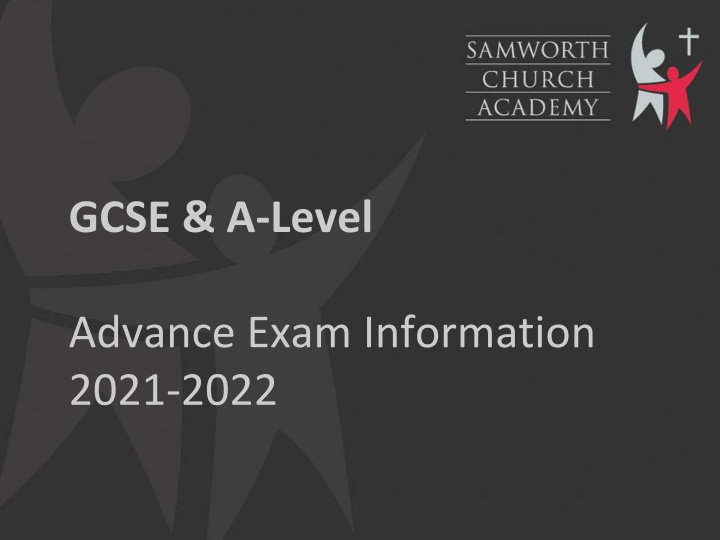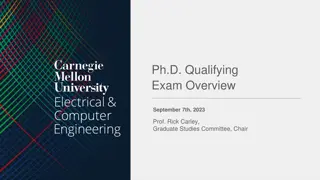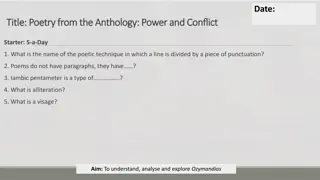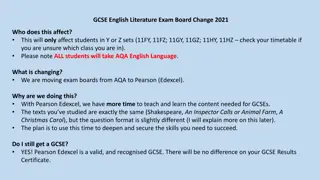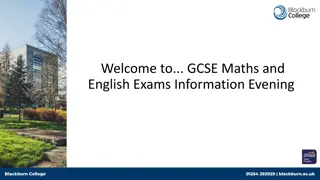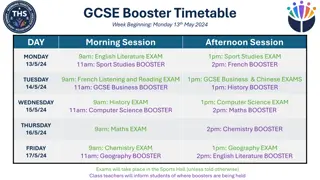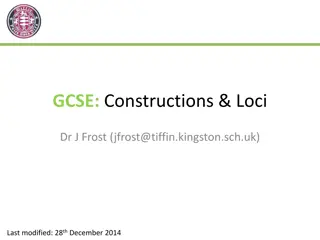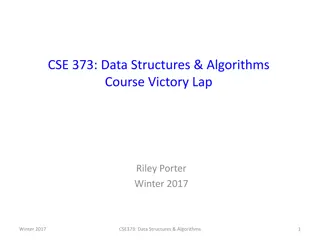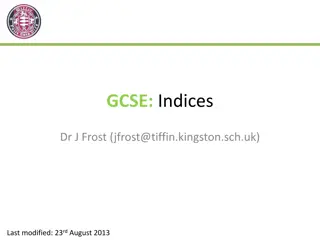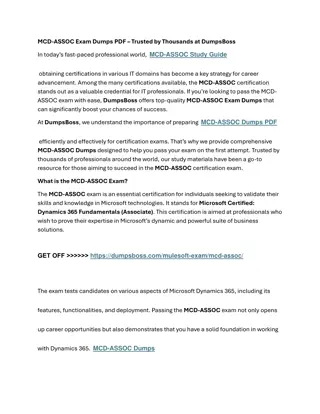GCSE & A-Level Advance Exam Information
Advance information for 2021-2022 exams provides details on aspects of the specification to be assessed, supporting revision without altering exam structures. It covers various subjects, excluding some due to assessment nature or new options introduced. The information does not encompass everything on exams, aiming to aid revision without restricting teaching. It should be used from release to support preparation, benefiting both teachers and students.
Download Presentation

Please find below an Image/Link to download the presentation.
The content on the website is provided AS IS for your information and personal use only. It may not be sold, licensed, or shared on other websites without obtaining consent from the author.If you encounter any issues during the download, it is possible that the publisher has removed the file from their server.
You are allowed to download the files provided on this website for personal or commercial use, subject to the condition that they are used lawfully. All files are the property of their respective owners.
The content on the website is provided AS IS for your information and personal use only. It may not be sold, licensed, or shared on other websites without obtaining consent from the author.
E N D
Presentation Transcript
GCSE & A-Level Advance Exam Information 2021-2022
What is advance information? Advance information is intended to communicate in advance some of the aspects of the specification that will be assessed in the examination papers. The breadth, depth and presentation of the advance information will vary between subjects to reflect their different characteristics. The information will detail the focus of particular aspects of the examination; for example, the content, contexts, texts, topics, sub- topics, themes and skills that will be assessed in the 2022 exams. This information will look different across a variety of subjects. It will support revision in the time before the examination.
Will advance information change how exams look/are structured? No. Advance information does not require any changes to a question paper s usual structure, which means that the examination assessments will: - Be familiar to teachers and students. - Allow continued relevance of associated assessment and teaching resources, including past papers. - Support student confidence in minimising the unexpected in the layout or structure of question papers.
Which subjects have advance information? It will be available for the majority of GCSE, AS and A level subjects. There will be advance information for all subjects except GCSE English Literature, History, Ancient History, Geography and Art and Design, and A and AS level Art and Design. The exceptions are either because of the nature of assessments in those subjects (assessment is by NEA in art and design qualifications) or because, following consultation by DfE and Ofqual, it has been decided that advance information will not be provided in subjects where optionality (students having a choice) is being introduced for 2022.
Does advance information cover everything on exams? NO. The advance information will not always detail everything that is in the examination. In some cases this would risk good education, progression, or fair results; in others it would be unhelpful to teachers and students, for example by listing topics that could lead to excessive teaching or revision on areas that are worth few marks.
How and when should advance information be used? - - Advance information can be used from the point of release. It can be used flexibly by centres to achieve its purpose of supporting revision. It should not, however, be used to narrow teaching and learning. It can be used by teachers in supporting their students revision and referred to by students in their revision and final examination preparation. It cannot be brought into the examinations. It will not be at a level that allows questions to be predicted or answers prepared. Preparation should continue to focus on knowledge and understanding that can be applied appropriately in the context of unseen examination questions. - - - -
GCSE Advance Information Subject: Business (Paper 1) Unit 1: Business in the real world Unit 3: Business Operations Purpose of Business Flow production Basic functions and types Efficiency: Lean production Dynamic nature (external environment Managing stick: Just in time and Just in case Business ownership Partnerships Total Quality Management Business ownership Private limited companies Ltds Benefits of good customer service (cust satisfaction, cust loyalty, increased spend, profitability) What are business aims and objectives The ways in which ICT has improved customer service (websites, e-commerce) Purpose of setting objectives Basic financial calculations (revenue, costs and profit) Unit 4: Human Resources Methods of expansion Organisational Structures Benefits and drawbacks of expansion Appropriateness of organisational structures Diseconomies of scale Methods of recruitment and selection of employees Unit 2: Influences on Business Importance of motivation in the workforce Consumer law Methods to motivate staff Importance of training the workforce Types of training
GCSE Advance Information Subject: Business (Paper 2) Unit 1: Business in the real world Unit 5: Marketing Public Limited Companies PLCs Purpose and methods of market research Purpose of business planning Pricing methods including loss leader Methods of expansion Factors influencing price (costs, nature of the market, competition, product lifecycle) Unit 2: Influences on Business Product (product differentiation, unique selling point, brand image) Ethical considerations Sustainability (global warming, using scarce resources) Product lifecycle (research and development, introduction, growth, maturity, decline, extension strategies: updating packaging, adding more or different features, changing target market, advertising, price reduction) Interest rates (how fluctuating interest rates can affect businesses that rely on overdrafts and loans for finance) Interest rates (how fluctuating interest rates can affect consumer and business spending) Product portfolio Consumer spending Promotional methods (PR, sponsorship) Unit 6: Finance Reasons for promotion (inform/remind customers about the product, create or increase sales, create or change the image of the product, persuade customers to buy the product) Sources of finance and appropriateness of these Interpreting cash flow forecasts Place (the different channels of distribution used by businesses including telesales Basic financial terms (Revenue, costs and profit) Average Rate of Return (ARR) Integrated nature of the marketing mix Break-even Components of financial statements
GCSE Advance Information Subject: Business (Quantitative Skills) Paper 1: Paper 2: Calculation of averages (Mean) Calculation of gross profit margin and net profit margin ratios Calculation of revenue, costs and profit Average Rate of Return (ARR) Interpretation of information from graphs and charts Cash flow forecasts, including total costs, total revenue and net cash flow Interpretation of information from graphs and charts
A-Level Advance Information Subject: Business (Paper 1) - Includes MCQs YEAR 2 CONTENT YEAR 1 CONTENT 3.7.1 Mission, corporate objectives and strategy 3.1.2 Understanding different business forms 3.7.2 Analysing the existing internal position of a business to assess strengths and weaknesses: financial ratio analysis 3.1.3 Understanding that businesses operate within an external environment 3.2.2 Understanding management decision making 3.2.3 Understanding the role and importance of stakeholders 3.7.3 Analysing the existing internal position of a business to assess strengths and weaknesses: overall performance 3.3.1 Setting marketing objectives 3.3.3 Making marketing decisions: segmentation, targeting, positioning 3.7.4 Analysing the external environment to assess opportunities and threats: political and legal change 3.3.4 Making marketing decisions: using the marketing mix 3.4.3 Making operational decisions to improve performance: increasing efficiency and productivity 3.8.1 Strategic direction: choosing which markets to compete in and what products to offer (Ansoff, Porter, Bowman) 3.4.4 Making operational decisions to improve performance: improving quality 3.8.2 Strategic positioning: choosing how to compete 3.5.1 Setting financial objectives 3.9.1 Assessing a change in scale 3.5.2 Analysing financial performance 3.9.4 Assessing greater use of digital technology 3.5.3 Making financial decisions: sources of finance 3.10.1 Managing change 3.5.4 Making financial decisions: improving cash flow and profits 3.10.3 Managing strategic implementation 3.6.2 Analysing human resource performance 3.10.4 Problems with strategy and why strategies fail 3.6.3 Making human resource decisions: improving organisational design and managing the human resource flow
A-Level Advance Information Subject: Business (Paper 2) YEAR 1 CONTENT 3.1.2 Understanding different business forms 3.3.1 Setting marketing objectives 3.3.2 Understanding markets and customers 3.3.3 Making marketing decisions: segmentation, targeting, positioning 3.3.4 Making marketing decisions: using the marketing mix 3.4.5 Making operational decisions to improve performance: managing inventory and supply chains 3.6.4 Making human resource decisions: improving motivation and engagement YEAR 2 CONTENT 3.7.5 Analysing the external environment to assess opportunities and threats: economic change 3.8.1 Strategic direction: choosing which markets to compete in and what products to offer (Ansoff) 3.9.1 Assessing a change in scale 3.10.4 Problems with strategy and why strategies fail
A-Level Advance Information Subject: Business (Paper 3) YEAR 1 CONTENT 3.2.3 Understanding the role and importance of stakeholders 3.3.4 Making marketing decisions: using the marketing mix 3.5.2 Analysing financial performance 3.5.3 Making financial decisions: sources of finance 3.5.4 Making financial decisions: improving cash flow and profits YEAR 2 CONTENT 3.9.1 Assessing a change in scale 3.9.2 Assessing innovation 3.10.2 Managing organisational culture 3.10.3 Managing strategic implementation 3.10.4 Problems with strategy and why strategies fail
A Level Advance Information Subject: Business (Quantitative Skills) Paper 2: Paper 1: Calculate, use and understand percentages and percentage changes Calculate, use and understand percentages and percentage changes Construct and interpret a range of standard graphical forms Calculate, use and understand ratios, averages and fractions Interpret, apply and analyse information in written, graphical and numerical forms Construct and interpret a range of standard graphical forms Interpret values of price and income elasticity of demand Interpret, apply and analyse information in written, graphical and numerical forms Use and interpret quantitative and non-quantitative information in order to make decisions Calculate cost, revenue, profit and break-even Paper 3: Calculate, use and understand percentages and percentage changes Calculate, use and understand ratios, averages and fractions Construct and interpret a range of standard graphical forms Interpret, apply and analyse information in written, graphical and numerical forms Use and interpret quantitative and non-quantitative information in order to make decisions
A-Level Advance Information Subject: Accounting Paper 1 Paper 2 Section B Section B 3.6 - Preparation of financial statements of sole traders 3.10 - Marginal Costing 3.11 - Standard costing and variance analysis 3.8 - Analysis and evaluation of financial information Section C 3.12 - Absorption and activity based costing 3.16 - Accounting for limited companies 3.13 - Capital investment appraisal Section C 3.2 - Types of business organisation Reminder: Topics not listed will be assessed in Section A (multiple choice, short answer and method questions) as well as synoptic elements of section B and C questions 3.15 - Partnership accounts 3.16 - Accounting for limited companies 3.17 - Interpretation, analysis and communication of accounting information
What happens next? Completion of teaching of the specification Targeted homework tasks Teaching focused on advance information areas Intervention focused on advance information areas Timed exam past paper practice Student completion of revision materials Student completion of feedback to mock exams Any issues or questions please ensure you ask?
